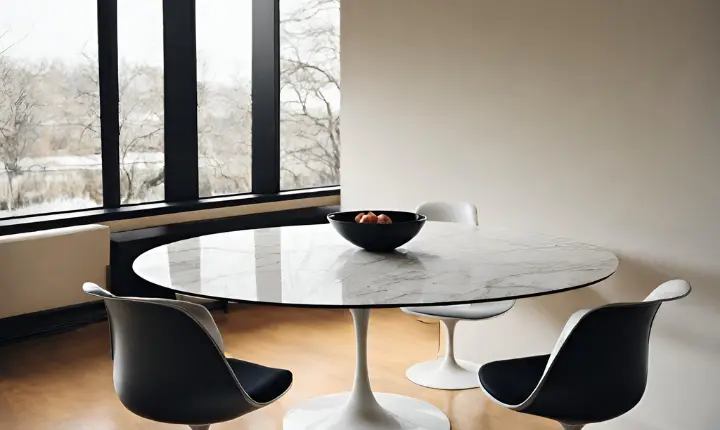In the ever-evolving world of furniture design, certain pieces stand out as true classics, embodying a perfect fusion of form and function. The Knoll Tulip Table, designed by the visionary Eero Saarinen in the 1950s, is one such masterpiece that has transcended time, becoming an enduring symbol of modernist design. This essay delves into the classic elegance of the Knoll Tulip Table, highlighting its defining characteristics, design ethos, and long-lasting influence on the interior design industry.
The Origin of Elegance:

With the Tulip Table, Finnish-American architect and designer Eero Saarinen aimed to transform the conventional notion of table design. Saarinen was frustrated by the “slum of legs” beneath traditional tables and set out to design a piece that radiated elegance and simplicity. As a consequence, a table with a single pedestal base was produced, doing away with the requirement for four legs and producing a smooth, eye-catching design.
Aesthetic Harmony in Form and Function:
At the heart of the Tulip Table’s allure is its harmonious blend of form and function. The distinctive pedestal base not only serves as a visual focal point but also addresses practical concerns, offering more legroom for those seated around it. The absence of sharp edges and corners further contributes to its appeal, making it a family-friendly and space-conscious choice for various settings.
Versatility in Design:
One of the key strengths of the Knoll Tulip Table lies in its versatility. Whether adorning a dining room, a conference room, or a chic cafe, the table effortlessly adapts to its surroundings. The availability of circular and oval tabletops in different sizes adds to its adaptability, allowing it to complement diverse interior styles.
The Marble Tulip Table 36:
For those seeking an extra touch of luxury, the Marble Tulip Table 36 emerges as a sophisticated variant of the classic design. Featuring a tabletop crafted from high-quality marble, this iteration elevates the Tulip Table to new heights of opulence. The natural variations in the marble patterns make each table a unique work of art, adding a layer of exclusivity to its aesthetic appeal.
Enduring Legacy:
Decades after its initial conception, the Knoll Tulip Table continues to be a design icon that resonates with lovers of modernist aesthetics. Its enduring popularity can be attributed to its ability to transcend trends, remaining eternally relevant in an ever-changing design landscape. The Saarinen Tulip Table has become a symbol of refined taste and a testament to the enduring impact a well-crafted piece of furniture can have on our living spaces.
Pros:
- Timeless Design: The Knoll Tulip Table boasts a design that has proven to be timeless, remaining relevant and stylish for decades.
- Space Efficiency: The single pedestal base not only adds to the table’s aesthetic appeal but also allows for more legroom, making it a practical choice for smaller spaces.
- Versatility: The table’s adaptable design makes it suitable for various settings, from dining rooms to conference rooms, adding a touch of sophistication to any space.
- Quality Craftsmanship: Knoll is known for its commitment to quality, and the Tulip Table is no exception. The table is crafted with precision and attention to detail, ensuring durability and longevity.
- Marble Variant: The Marble Tulip Table 36 introduces a luxurious variant, featuring a stunning marble tabletop that adds a touch of opulence to the classic design.
- Iconic Pedestal Base: The pedestal base not only serves a functional purpose but also serves as a design statement, contributing to the table’s iconic status.
Cons:
- Price: The Knoll Tulip Table is a premium piece of furniture, and its price point may be a deterrent for budget-conscious consumers.
- Weight: The sturdy construction of the table, particularly in the marble variant, can make it heavy and challenging to move.
- Surface Sensitivity: While the marble variant adds luxury, it may also be more susceptible to scratches or stains compared to tables with other finishes.
- Limited Customization: While the Tulip Table comes in various sizes and finishes, some users might prefer more extensive customization options in terms of materials or shapes.
- Availability: Due to its popularity and demand, the Knoll Tulip Table may not always be readily available, leading to potential wait times for those looking to purchase.
- Modernist Aesthetic: The distinctive modernist design may not be to everyone’s taste, and some individuals might prefer more traditional or eclectic styles.
(FAQs)
Q. What is the Knoll Tulip Table?
- The Knoll Tulip Table is a classic piece of furniture designed by Eero Saarinen in the 1950s. It is known for its minimalist, modernist design, featuring a single pedestal base and a circular or oval tabletop.
Q. What materials are used in the construction of the Knoll Tulip Table?
- The tabletop is typically made of materials like laminate, wood, or marble, while the base is constructed from aluminum or fiberglass, depending on the specific model.
Q. What sizes are available for the Knoll Tulip Table?
- The table is available in various sizes, with options for both circular and oval tabletops. Sizes can range to accommodate different needs, from small dining tables to larger conference tables.
Q. Is the Knoll Tulip Table suitable for small spaces?
- Yes, the Tulip Table is well-suited for smaller spaces due to its single pedestal base, which eliminates the need for multiple legs, providing more legroom and a visually uncluttered look.
Q. Can I customize the Knoll Tulip Table?
- While there are different finishes and sizes available, the customization options are somewhat limited. Buyers can choose from various materials and sizes offered by Knoll.
Conclusion
The Knoll Tulip Table is a design classic celebrated for its elegance and functionality. While it has its set of considerations, its enduring popularity attests to its status as a symbol of timeless design. Prospective buyers should weigh the pros and cons based on their preferences, budget, and the specific needs of their living or working space.
